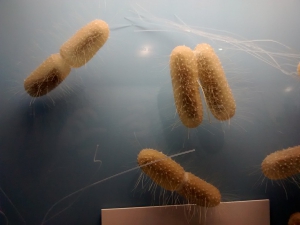The Gut Micro-bio what?
Jessica Turton
21/6/2019

What is the Gut Micro Biome?
Our body is a plethora of bugs! These microbes have incredibly diverse and essential roles in the way we thrive and function day to day, including but certainly not limited to, the digestion of food as well as hormone production. What we are more recently beginning to discover is that the gut micro biome is not only as unique in individuals as our fingerprints, it can also have an enormous impact on our health and longevity. It’s time to realise that our gut is much more than just a pipe for our food to move through, a place of nutrient absorption, or something we rub after regrettably overeating at dinner – our gut is a key director in our health. In fact, there are over 100 million neurons in the gut, which is more than our spinal cord! 1
The Role of the Gut in Modern Chronic Disease
Why all this sudden interest in the gut micro biome? Common features of metabolic and inflammatory diseases such as diabetes, obesity and cardiovascular disease include an altered gut microbiota composition and a pro-inflammatory state. 2 Additionally, it is now being understood that specific microbiota profiles can predispose us to obesity and weight gain. 3 It is also known that the gut itself has a direct impact on the health of the brain, and the production of cytokines within the gut can cause the brain to produce more cortisol. 4 Cortisol is the most commonly known stress hormone and a very serious contributor to the chronic conditions mentioned. It is revitalising to know that there is so much more we can do to combat these pulsing epidemics. For so long we’ve been looking in the wrong places for the answers to today’s health problems. It’s time to look in the gut.
Problems with Current Diet and Lifestyle
So what’s the problem then – why are our guts not healthy? Environmental stressors including Westernised diets, sedentary lifestyles, high pressure careers, lack of sleep, overuse of prescription medications alongside toxins in food, water and air have created an incongruity between our genome and what our body is actually expecting. 4 We’ve already mentioned that our gut is capable of stimulating the production of cortisol, but what is more concerning is the cyclic effect of cortisol back on the gut. Cortisol increases the permeability (leakiness) of our intestinal walls and can negatively disrupt the balance of organisms that reside both inside and outside the gut. Every structure and function of the body works very differently when the body is under stress, and regulating the adrenals to achieve a place of balance is of uttermost importance for someone who has poor gut health.
The Stages of Gut Healing
The great news about all of this is that the solutions to gut health, though individual, tend to be a reversion back to whole, tasty and nutrient-dense foods parallel to practices that reduce life stressors. Healing the gut can result in the remission of inflammation and autoimmune symptoms such as joint pain, fatigue and bloating. However, it is important not to jump into using conventional measures to “fix” your gut (e.g probiotic supplementation) if you have existing poor gut health. As such, the general process of healing comes in two stages; stage 1) reducing pathogenic bacteria to relieve symptoms and heal the gut, and stage 2) repopulating bacteria into the gut with a diet as diverse as possible. The more gut imbalances one has (e.g. inflammatory bowel disease, irritable bowel syndrome), the better they do on a low-fibre, low-prebiotic diet initially. 4 Prebiotics are compounds that feed and encourage bacterial growth and foods containing natural prebiotics include onions, garlic, broccoli, cabbage, wheat plus more. The challenge lies in identifying the stringency of restriction during the gut healing phase (stage 1) and pinpointing how and when the micro biome should be repopulated (stage 2). As such, a dietitian is a useful partner in your individual gut microbiota investigation.
Diet Patterns for Optimisation of Gut Micro Biome Health
So once we’ve healed the gut, how can we achieve and maintain optimal gut health? A few well-known diet trends and lifestyles have proven their effectiveness when it comes to the species and diversity of the microbes within us. Firstly, a high-fibre diet is key. The average omnivore consumes about 19 grams of fibre each day, the average vegan consumes 43 grams, while contemporary hunter-gatherer societies may consume upwards of 100 grams daily! 3,5 Fibre is what feeds the beneficial bacteria and a low intake tends to result from monotonous diets with poor vegetable consumption. The more diverse the diet, the more diverse the micro biome and the more resilient it becomes to disturbances. 6 Modern dietary choices that exclude animal or plant products will narrow the gastrointestinal micro biome and may be the silent blockade to optimal health for millions of people. 6 Diets that have proven to be beneficial for gut health include; Paleo, autoimmune Paleo, low FODMAP, intermittent fasting, low-carb high-fat, and even some gluten-free diets. All of these dietary patterns remove a lot of the foods that are toxic to our gut, including acellular carbohydrates which feed the harmful bacteria and cause dysbiosis (e.g. white flour, sugar, processed/refined foods). 3 It should be understood that in terms of gut healing (stage 1), low FODMAP diets are the most effective, yet for long term optimisation, individualisation is key and there is no “one size fits all”.
References
- Liu G. What is your gut telling you? [Video]. Austin: Paleo f(x); 2016.
- Saita D, Ferrarese R, Foglieni C, Esposito A, Canu T, Perani L, et al. Adaptive immunity against gut microbiota enhances apoE-mediated immune regulation and reduces atherosclerosis and western-diet-related inflammation. Scientific reports. 2016;6:29353.
- Kresser C. What is your gut telling you? [Video]. Austin: Paleo f(x); 2016.
- Perlmutter D. What is your gut telling you? [Video]. Austin: Paleo f(x); 2016.
- Leach J. Paleo versus vegetarian – who eats more fiber? [Internet]. 2015 [cited 2016 10 Jul]. Available from: http://humanfoodproject.com/paleo-versus-vegetarian-who-eats-more-fiber/.
- Heiman ML, Greenway FL. A healthy gastrointestinal microbiome is dependent on dietary diversity. Molecular Metabolism. 2016;5(5):317-20.
This article provides general information from the current scientific evidence base and clinical judgement of the author. It is designed for educational purposes only and should not be substituted for medical advice. The author recommends you seek personally tailored support from a qualified healthcare practitioner before undertaking any major lifestyle change.



